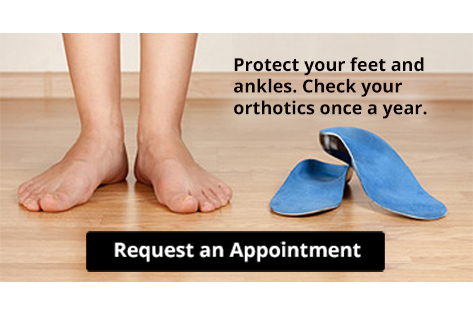Items filtered by date: December 2024
Diabetic Neuropathy and the Feet
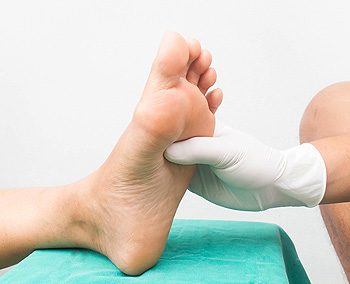
Diabetic neuropathy is a common complication of diabetes that can cause nerve damage in the feet, toes, and ankles. Elevated blood sugar levels over time can harm the peripheral nerves, leading to symptoms such as numbness, tingling, burning sensations, or sharp pain. Many people experience a gradual loss of sensation, which increases the risk of unnoticed injuries like blisters or cuts. Left untreated, these minor wounds can lead to serious infections, ulcers, and, in severe cases, gangrene or amputation. Reduced muscle strength and coordination from neuropathy may also affect balance and gait, increasing the risk of falls. To prevent complications from diabetic neuropathy, it is important to maintain proper foot care and routine foot inspections. A podiatrist can perform an exam to assess nerve function, detect early signs of problems, and provide treatment for wounds or other foot issues. This foot doctor can also offer advice on footwear to reduce pressure and prevent injury. If you are experiencing symptoms of diabetic neuropathy, it is suggested that you schedule an appointment with a podiatrist for an exam and ongoing treatment.
Neuropathy
Neuropathy can be a potentially serious condition, especially if it is left undiagnosed. If you have any concerns that you may be experiencing nerve loss in your feet, consult with Richard P. Jacoby, DPM from Extremity Health Centers. Our doctor will assess your condition and provide you with quality foot and ankle treatment for neuropathy.
What Is Neuropathy?
Neuropathy is a condition that leads to damage to the nerves in the body. Peripheral neuropathy, or neuropathy that affects your peripheral nervous system, usually occurs in the feet. Neuropathy can be triggered by a number of different causes. Such causes include diabetes, infections, cancers, disorders, and toxic substances.
Symptoms of Neuropathy Include:
- Numbness
- Sensation loss
- Prickling and tingling sensations
- Throbbing, freezing, burning pains
- Muscle weakness
Those with diabetes are at serious risk due to being unable to feel an ulcer on their feet. Diabetics usually also suffer from poor blood circulation. This can lead to the wound not healing, infections occurring, and the limb may have to be amputated.
Treatment
To treat neuropathy in the foot, podiatrists will first diagnose the cause of the neuropathy. Figuring out the underlying cause of the neuropathy will allow the podiatrist to prescribe the best treatment, whether it be caused by diabetes, toxic substance exposure, infection, etc. If the nerve has not died, then it’s possible that sensation may be able to return to the foot.
Pain medication may be issued for pain. Electrical nerve stimulation can be used to stimulate nerves. If the neuropathy is caused from pressure on the nerves, then surgery may be necessary.
If you have any questions, please feel free to contact one of our offices located in Scottsdale and Buckeye, AZ . We offer the newest diagnostic and treatment technologies for all your foot care needs.
Staying Injury Free in Pickleball
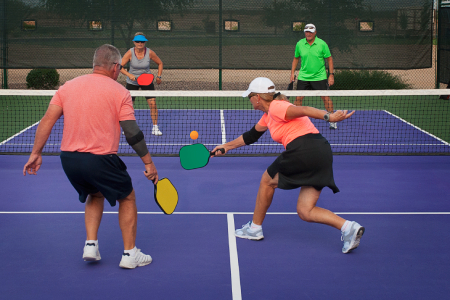
Pickleball, governed by rules similar to tennis, involves players rallying a lightweight plastic ball over a net on a compact 44 by 20 foot court. While its low-impact nature makes it appealing to athletes of all levels, the sport demands quick reflexes, balance, and agility, increasing the risk of injuries. Senior players are especially vulnerable, with sprains, strains, ruptures, and falls being most common. Women are more prone to fractures due to lower bone density, while reduced conditioning in older adults compounds the risk. Proper footwear designed for lateral movement and a thorough warm-up routine are critical for preventing injuries. If an injury occurs, non-surgical treatments such as rest, targeted exercises, or bracing are often effective, depending on severity. By taking these precautions, players can enjoy the social and physical benefits of pickleball without compromising their health. If you have sustained a lower extremity injury while playing pickleball, it is suggested that you seek treatment from a podiatrist.
Foot and ankle trauma is common among athletes and the elderly. If you have concerns that you may have experienced trauma to the foot and ankle, consult with Richard P. Jacoby, DPM from Extremity Health Centers. Our doctor will assess your condition and provide you with quality foot and ankle treatment.
Foot and ankle trauma cover a range of injuries all over the foot; common injuries include:
- Broken bones
- Muscle strains
- Injuries to the tendons and ligaments
- Stress fractures
Symptoms
Symptoms of foot and ankle injuries vary depending on the injury, but more common ones include:
- Bruising
- Inflammation/ Swelling
- Pain
Diagnosis
To properly diagnose the exact type of injury, podiatrists will conduct a number of different tests. Some of these include sensation and visual tests, X-rays, and MRIs. Medical and family histories will also be taken into account.
Treatment
Once the injury has been diagnosed, the podiatrist can than offer the best treatment options for you. In less severe cases, rest and keeping pressure off the foot may be all that’s necessary. Orthotics, such as a specially made shoes, or immobilization devices, like splints or casts, may be deemed necessary. Finally, if the injury is severe enough, surgery may be necessary.
If you have any questions, please feel free to contact one of our offices located in Scottsdale and Buckeye, AZ . We offer the newest diagnostic and treatment technologies for all your foot care needs.
Reminder: When Was the Last Time...?
Benefits of Choosing the Right Shoe Size
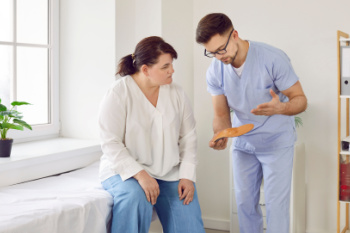
Choosing the right shoe size is essential for overall foot health and comfort. Wearing shoes that are too tight can lead to blisters, calluses, and even long-term conditions like bunions or hammertoes. Shoes that are too loose can cause instability, leading to slips, falls, or joint pain. Properly fitting shoes provide adequate support to the arches, cushioning to absorb shock, and protection from external pressure. They can help improve posture, reduce foot fatigue, and prevent injuries by promoting better alignment. Additionally, the right shoe size enhances overall comfort during physical activities like running, walking, or standing for extended periods. When shoes fit well, they allow for natural foot movement, providing a balance of support and flexibility, which is essential for maintaining foot health and avoiding discomfort. If you have endured foot pain from wearing the wrong shoe size, it is suggested that you contact a podiatrist who can offer relief techniques, and guide you on how to find your correct shoe size.
Getting the right shoe size is an important part of proper foot health. Seek the assistance of Richard P. Jacoby, DPM from Extremity Health Centers. Our doctor will provide the care you need to keep you pain-free and on your feet.
Getting the Right Shoe Size
There are many people who wear shoes that are the incorrect size, negatively affecting their feet and posture. Selecting the right shoes is not a difficult process, so long as you keep several things in mind when it comes to choosing the right pair.
- When visiting the shoe store, use the tools available to measure your foot.
- Be sure there is ‘wiggle room’. There should be about an inch between your toes and the tip of your shoes.
- Do not always assume you are the same size, as manufacturers run differently.
- Purchase shoes later in the day, as your feet swell as the day progresses.
- If a shoe is not comfortable, it is not suitable. Most shoes can’t be ‘broken in’, and comfort should be the ultimate goal when it comes to choosing the right pair of shoes
As our feet hold our body weight and keep us moving, it is important to treat them right. Picking the right pair of shoes can provide your feet comfort and mobility without pain.
If you have any questions, please feel free to contact one of our offices located in Scottsdale and Buckeye, AZ . We offer the newest diagnostic and treatment technologies for all your foot care needs.
Reasons and Treatment for Cracked Heels
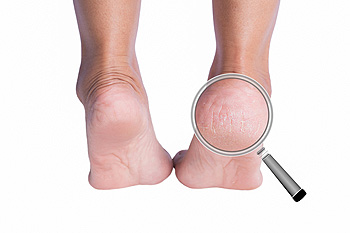
Cracked heels are a common foot issue that can cause discomfort and pain. The main reason for cracked heels is dry skin, which can be exacerbated by factors such as standing for long periods, wearing open-back shoes, or exposure to harsh weather conditions. Other causes include obesity, diabetes, and certain skin conditions like eczema. When the skin loses moisture and elasticity, it can become thickened and eventually crack, leading to pain and potential infection. A podiatrist can treat cracked heels by thoroughly examining the feet and providing professional care. Treatment may involve debridement to remove dead skin, moisturizing therapies, and recommending proper footwear. Podiatrists may also suggest orthotics or other interventions to address any underlying causes, ensuring the feet heal properly and preventing future cracks. If you have developed cracked heels, it is suggested that you consult a podiatrist who can offer prescribed medication as part of a successful treatment regime.
Cracked heels are unsightly and can cause further damage to your shoes and feet. If you have any concerns, contact Richard P. Jacoby, DPM from Extremity Health Centers. Our doctor can provide the care you need to keep you pain-free and on your feet.
Cracked Heels
Cracked heels appear unappealing and can make it harder for you walk around in sandals. Aside from looking unpleasant, cracked heels can also tear stockings, socks, and wear out your shoes. There are several methods to help restore a cracked heel and prevent further damage.
How Do You Get Them?
Dry skin is the number one culprit in creating cracked heels. Many athletes, walkers, joggers, and even swimmers suffer from cracked heels. Age and skin oil production play a role to getting cracked heels as well.
Promote Healing
Over the counter medicines can help, especially for those that need instant relief or who suffer from chronic dry feet.
Wear Socks – Wearing socks with medicated creams helps lock in moisture.
Moisturizers – Applying both day and night will help alleviate dryness which causes cracking.
Pumice Stones – These exfoliate and remove dead skin, which allows for smoother moisturizer application and better absorption into the skin.
Change in Diet
Eating healthy with a well-balanced diet will give the skin a fresh and radiant look. Your body responds to the kinds of food you ingest. Omega-3 fatty acids and zinc supplements can also revitalize skin tissue.
Most importantly, seek professional help if unsure how to proceed in treating cracked heels. A podiatrist will help you with any questions or information needed.
If you have any questions, please feel free to contact one of our offices located in Scottsdale and Buckeye, AZ . We offer the newest diagnostic and treatment technologies for all your foot care needs.
What Is Onychogryphosis?
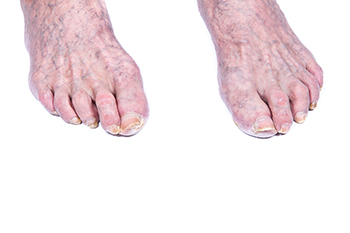
Onychogryphosis, commonly called ram’s horn nails, causes the toenails to thicken, harden, and grow in a curved, claw-like shape. It usually affects the big toe and discomfort or pain can be felt, particularly when wearing shoes or walking. This condition is more common in older adults, individuals with limited mobility, and those who have experienced trauma to the toes, which may trigger abnormal nail growth. Poor circulation, improper nail care, and underlying health conditions like diabetes can also increase the risk of developing onychogryphosis. Diagnosis involves a physical examination by a podiatrist, who may use imaging tests to assess the severity. Management typically includes regular trimming and thinning of the nail, and in severe cases, partial or complete nail removal. If you have any symptoms of this condition, it is suggested that you visit a podiatrist who can provide proper care and guidance to manage symptoms and prevent complications.
Proper foot care is something many older adults forget to consider. If you have any concerns about your feet and ankles, contact Richard P. Jacoby, DPM from Extremity Health Centers. Our doctor can provide the care you need to keep you pain-free and on your feet.
The Elderly and Their Feet
As we age we start to notice many changes in our body, but the elder population may not notice them right away. Medical conditions may prevent the elderly to take notice of their foot health right away. Poor vision is a lead contributor to not taking action for the elderly.
Common Conditions
- Neuropathy – can reduce feeling in the feet and can hide many life-threatening medical conditions.
- Reduced flexibility – prevents the ability of proper toenail trimming, and foot cleaning. If left untreated, it may lead to further medical issues.
- Foot sores – amongst the older population can be serious before they are discovered. Some of the problematic conditions they may face are:
- Gouging toenails affecting nearby toe
- Shoes that don’t fit properly
- Pressure sores
- Loss of circulation in legs & feet
- Edema & swelling of feet and ankles
Susceptible Infections
Diabetes and poor circulation can cause general loss of sensitivity over the years, turning a simple cut into a serious issue.
If you have any questions please feel free to contact one of our offices located in Scottsdale and Buckeye, AZ . We offer the newest diagnostic and treatment technologies for all your foot and ankle needs.
